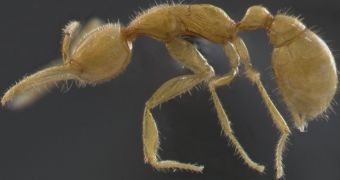A new species of blind, underground predatory ant has been discovered in the Amazon, and it seems that it descends from the first ant lineages, which appeared 120 million years ago.
During his research studies in the Amazonian jungle area, near the city of Manaus, Brazil, Christian Rabeling from the University of Texas discovered an ant belonging to the first novel subfamily of living ants (21 in number) found since 1923. This is the late uncle of the common insects that now form the vastest animal family on Earth (15% of its biomass), and it was named Martialis Heureka ("The ant from Mars"), since it shows unique distinctive features, unlike anything seen before.
This is actually the third specimen of its kind ever found, but the first two, discovered by Manfred Verhaagh from the Museum of Natural History in Germany, dried and shattered upon handling while being sent back for DNA analysis. But the existing specimen found later by Rabeling (and which received the rediscovery joy shout "Heureka" as a second name) brought enough evidence that it belonged to a new species, genus and subfamily, with a phylogenetic position placed at the base of ants' evolutionary tree.
The pale, eyeless insect, which measures 2 to 3 mm in length, is provided with large mandibles and is perfectly adapted to living in soil. In Rabeling's opinion, the insect adapted in time to underground living conditions (color loss, blindness), while still maintaining some characteristics from its long-gone "proto-ant" ancestors. The first ants are believed to have evolved from wasps more than 120 million years ago. Very quickly, they morphed into various lineages, specializing in living on trees, on the ground or under it. Martialis Heureka proves that last one. "This discovery lends support to the idea that blind subterranean predator ants arose at the dawn of ant evolution," states Rabeling. "Based on our data and the fossil record, we assume that the ancestor of this ant was somewhat wasp-like, perhaps similar to the Cretaceous amber fossil Sphecomyrma, which is widely known as the evolutionary missing link between wasps and ants."
According to him, "This discovery hints at a wealth of species, possibly of great evolutionary importance, still hidden in the soils of the remaining rainforests."

 14 DAY TRIAL //
14 DAY TRIAL //